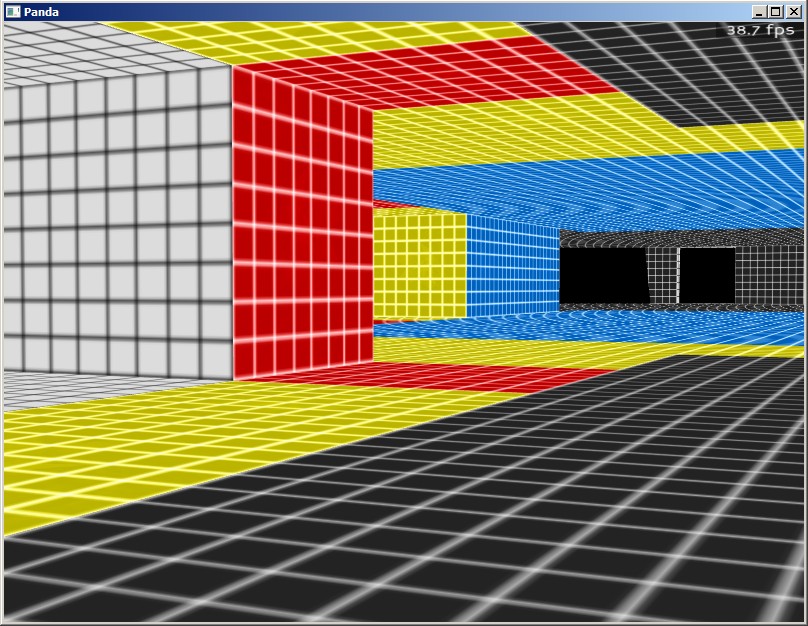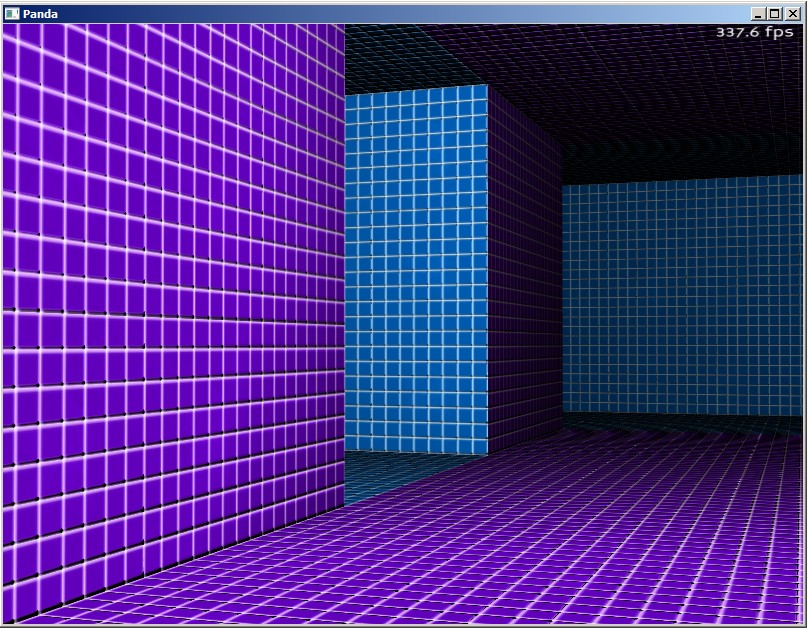To help myself learn Panda, I’m adapting a random dungeon generator, creating the geometry and applying the materials and textures at runtime. I have it working nicely, up until the point where I try to apply separate textures to different areas of the dungeon.
In the attached images, you can see how the model looks without multiple textures and what happens when I apply more than one texture. When I add multiple textures, I lose all normal mapping, texture scaling, and lighting effects. My frame rate also drops significantly.
Some code snippets:
if usecolor:
ts = TextureStage("tex")
myDungeon.setTexScale(ts, 3, 3, 1)
ts = TextureStage("bump")
myDungeon.setTexScale(ts, 3, 3, 1)
myMaterial = Material()
myMaterial.setShininess(10.0) #Make this material shiny
myDungeon.setMaterial(myMaterial)
else:
tex = loader.loadTexture("models/dungeon/white_tile.jpg")
myDungeon.setTexture(tex)
myDungeon.setTexScale(TextureStage.getDefault(), 3, 3, 1)
tex = loader.loadTexture("models/dungeon/tile_bump2.jpg")
ts = TextureStage("bump")
ts.setMode(TextureStage.MNormal)
myDungeon.setTexScale(ts, 3, 3, 1)
myDungeon.setTexture(ts, tex)
myMaterial = Material()
myMaterial.setShininess(10.0) #Make this material shiny
myDungeon.setMaterial(myMaterial)def colorNode(self):
for index in range(self.geomnode.getNumGeoms()):
if self.usecolor:
color = self.color_lookup[index]
name = self.colornames
tex = loader.loadTexture("models/dungeon/%s_tile.jpg" %(name))
else:
tex = loader.loadTexture("models/dungeon/white_tile.jpg")
texAttrib = TextureAttrib.make()
ts_tex = TextureStage("tex")
ts_tex.setMode(TextureStage.MDecal)
texAttrib = texAttrib.addOnStage(ts_tex, tex)
bump = loader.loadTexture("models/dungeon/tile_bump2.jpg")
ts_bump = TextureStage("bump")
ts_bump.setMode(TextureStage.MNormal)
texAttrib = texAttrib.addOnStage(ts_bump, bump)
newRenderState = self.geomnode.getGeomState(index).addAttrib(texAttrib)
self.geomnode.setGeomState(index, newRenderState)
self.geomnode.unify(self.geomnode.getNumGeoms(),1)I’m evidently doing something wrong, in the texAttrib portion of the process. The trouble I’m having is that multiple textures need to be set on the geomNode level, but then I have to set materials and texture scaling on the nodePath level. Somewhere in the jump between these, I assume, I’m missing something. It’s a puzzle. 
Can anyone offer any assistance with this?
I also have a question about octree implementation for the same project, but… one question at a time. 






 It’s clear to me that this is not a good example (yet) of how to make a decent game in Panda. I’m not setting things up the right way in my main loop, if I can’t readily enable a restart function. So there’s some work yet to do.
It’s clear to me that this is not a good example (yet) of how to make a decent game in Panda. I’m not setting things up the right way in my main loop, if I can’t readily enable a restart function. So there’s some work yet to do. Every topic I’ve seen that delves into setting multiple textures, for instance, suggests avoiding the low-level texAttrib approach and creating a new geomNode for each geom. This code shows that the texAttrib features can be used without losing the ability to use setTexScale and other higher-level texture manipulation functions for the geometries. I’ve also seen nothing on the forum about how to generate binormals and tangents on the fly, which this script does. (It’s not difficult. Just a couple of additional crossproduct steps, to get the full set of orthonormal vectors.)
Every topic I’ve seen that delves into setting multiple textures, for instance, suggests avoiding the low-level texAttrib approach and creating a new geomNode for each geom. This code shows that the texAttrib features can be used without losing the ability to use setTexScale and other higher-level texture manipulation functions for the geometries. I’ve also seen nothing on the forum about how to generate binormals and tangents on the fly, which this script does. (It’s not difficult. Just a couple of additional crossproduct steps, to get the full set of orthonormal vectors.) So, you know. I’m left guess as to why there is this slowdown.
So, you know. I’m left guess as to why there is this slowdown.